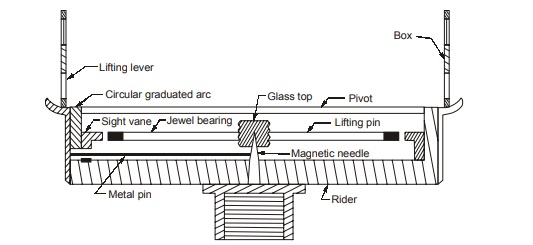SURVEYOR’S COMPASS
The figure below shows the cross-sectional view of a surveyor’s compass. It consist of a brass or aluminium circular box of about 150 mm diameter.

- The graduations are in degree and half degrees.
- Edge bar needle is used in surveyor’s compass.
- Surveyor’s compass is used to measure quadrantal bearing of a line. After the necessary temporary adjustments, the needle is released to swing freely on the pivot. In order to determine the quadrantal bearing of a line (say PQ), then compass is set up at P. The compass is then turned so that the object vane is directed to the ranging rod at station Q. Thus the line of sight is now along PQ. Bring the hair of the object vane exactly over the ranging rod by rotating the compass, if required. Take the reading on the graduated ring at north end of the needle. The surveyor is required to move to the position near the north end of the needle for taking the reading. This gives the quadrantal bearing of the line PQ.
<< Previous | Next >>
Must Read: What is Surveying?
WhatsApp Group
Join Now
Telegram Group
Join Now

